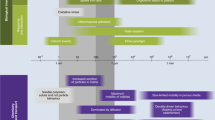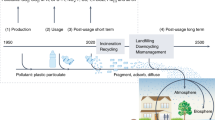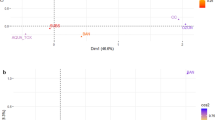Abstract
The threat posed by plastic in the environment is poorly characterized due to uncertainties and unknowns about sources, transport, transformation and removal processes, and the properties of the plastic pollution itself. Plastic creates a footprint of particulate pollution with a diversity of composition, size and shape, and a halo of chemicals. In this Perspective, we argue that process-based mass-balance models could provide a platform to synthesize knowledge about plastic pollution as a function of its measurable intrinsic properties.
This is a preview of subscription content, access via your institution
Access options
Access Nature and 54 other Nature Portfolio journals
Get Nature+, our best-value online-access subscription
$29.99 / 30 days
cancel any time
Subscribe to this journal
Receive 12 digital issues and online access to articles
$99.00 per year
only $8.25 per issue
Buy this article
- Purchase on Springer Link
- Instant access to full article PDF
Prices may be subject to local taxes which are calculated during checkout



Similar content being viewed by others
References
Borrelle, S. B. et al. Predicted growth in plastic waste exceeds efforts to mitigate plastic pollution. Science 369, 1515–1518 (2020).
Geyer, R., Jambeck, J. R. & Law, K. L. Production, use and fate of all plastics ever made. Sci. Adv. 3, 1700782 (2017).
MacLeod, M., Arp, H. P. H., Tekman, M. B. & Jahnke, A. The global threat from plastic pollution. Science 373, 61–65 (2021).
Persson, L. M. et al. Confronting unknown planetary boundary threats from chemical pollution. Environ. Sci. Technol. 47, 12619–12622 (2013).
MacLeod, M. et al. Identifying chemicals that are planetary boundary threats. Environ. Sci. Technol. 48, 11057–11063 (2014).
Jahnke, A. et al. Reducing uncertainty and confronting ignorance about the possible impacts of weathering plastic in the marine environment. Environ. Sci. Technol. Lett. 4, 85–90 (2017).
Villarrubia-Gómez, P., Cornell, S. E. & Fabres, J. Marine plastic pollution as a planetary boundary threat—the drifting piece in the sustainability puzzle. Mar. Policy 96, 213–220 (2018).
Arp, H. P. H. et al. Weathering plastics as a planetary boundary threat: exposure, fate and hazards. Environ. Sci. Technol. 55, 7246–7255 (2021).
Persson, L. et al. Outside the safe operating space of the planetary boundary for novel entities. Environ. Sci. Technol. 56, 1510–1521 (2022).
United Nations Environment Assembly of the United Nations Environment Programme. Draft Resolution: End Plastic Pollution: Towards an International Legally Binding Instrument UNEP/EA.5/L.213/Rev.1 (UNEP, 2022); https://wedocs.unep.org/bitstream/handle/20.500.11822/38522/k2200647_-_unep-ea-5-l-23-rev-1_-_advance.pdf
Horton, A. A., Walton, A., Spurgeon, D. J., Lahive, E. & Svendsen, C. Microplastics in freshwater and terrestrial environments: evaluating the current understanding to identify the knowledge gaps and future research priorities. Sci. Total Environ. 586, 127–141 (2017).
Allen, D. et al. Microplastics and nanoplastics in the marine-atmosphere environment. Nat. Rev. Earth Environ. 3, 393–405 (2022).
Silva, A. B. et al. Microplastics in the environment: challenges in analytical chemistry—a review. Anal. Chim. Acta 1017, 1–19 (2018).
Rochman, C. M. et al. Rethinking microplastics as a diverse contaminant suite. Environ. Toxicol. Chem. 38, 703–711 (2019).
Bank, M. S., Mitrano, D. M., Rillig, M. C., Lin, C. S. K. & Ok, Y. S. Embrace complexity to understand microplastic pollution. Nat. Rev. Earth Environ. 3, 736–737 (2022).
Funtowicz, S. O. & Ravetz, J. R. A new scientific methodology for global environmental issues. Ecol. Econ. Sci. Manag. Sustain. 10, 137–152 (1991).
Wania, F. & Mackay, D. The evolution of mass balance models of persistent organic pollutant fate in the environment. Environ. Pollut. 100, 223–240 (1999).
Buser, A. M. et al. Good modeling practice guidelines for applying multimedia models in chemical assessments. Integr. Environ. Assess. Manag. 8, 703–708 (2012).
McKone, T. E. & MacLeod, M. Tracking multiple pathways of human exposure to persistent multimedia pollutants: regional, continental and global-scale models. Annu. Rev. Environ. Resour. 28, 463–492 (2003).
MacLeod, M., Scheringer, M., McKone, T. E. & Hungerbühler, K. The state of multimedia mass-balance modeling in environmental science and decision-making. Environ. Sci. Technol. 44, 8360–8364 (2010).
Wang, Z., Walker, G. W., Muir, D. C. & Nagatani-Yoshida, K. Toward a global understanding of chemical pollution: a first comprehensive analysis of national and regional chemical inventories. Environ. Sci. Technol. 54, 2575–2584 (2020).
Wiesinger, H., Wang, Z. & Hellweg, S. Deep dive into plastic monomers, additives and processing aids. Environ. Sci. Technol. 55, 9339–9351 (2021).
Uzun, P., Farazande, S. & Guven, B. Mathematical modeling of microplastic abundance, distribution and transport in water environments: a review. Chemosphere 288, 132517 (2022).
Koelmans, A. A., Kooi, M., Law, K. L. & Van Sebille, E. All is not lost: deriving a top-down mass budget of plastic at sea. Environ. Res. Lett. 12, 114028 (2017).
Kaandorp, M. L., Dijkstra, H. A. & van Sebille, E. Closing the Mediterranean marine floating plastic mass budget: inverse modeling of sources and sinks. Environ. Sci. Technol. 54, 11980–11989 (2020).
Baughman, G. L. & Lassiter, R. R. in Estimating the Hazard of Chemical Substances to Aquatic Life, Special Technical Publication Vol. 657 (ed. Cairns, J.) 35–54 (ASTM International, 1978).
Mackay, D. Finding fugacity feasible. Environ. Sci. Technol. 13, 1218–1223 (1979).
Mackay, D., Di Guardo, A., Paterson, S., Kicsi, G. & Cowan, C. E. Assessing the fate of new and existing chemicals: a five‐stage process. Environ. Toxicol. Chem. 15, 1618–1626 (1996).
Hollander, A., Schoorl, M. & van de Meent, D. SimpleBox 4.0: improving the model while keeping it simple. Chemosphere 148, 99–107 (2016).
Meesters, J. A., Koelmans, A. A., Quik, J. T., Hendriks, A. J. & van de Meent, D. Multimedia modeling of engineered nanoparticles with SimpleBox4nano: model definition and evaluation. Environ. Sci. Technol. 48, 5726–5736 (2014).
Liu, H. H., Bilal, M., Lazareva, A., Keller, A. & Cohen, Y. Simulation tool for assessing the release and environmental distribution of nanomaterials. Beilstein J. Nanotechnol. 6, 938–951 (2015).
Waldschläger, K. et al. Learning from natural sediments to tackle microplastics challenges: a multidisciplinary perspective. Earth Sci. Rev. 228, 104021 (2022).
Alimi, O. S., Farner-Budarz, J., Hernandez, L. M. & Tufenkji, N. Microplastics and nanoplastics in aquatic environments: aggregation, deposition and enhanced contaminant transport. Environ. Sci. Technol. 52, 1704–1724 (2018).
Hüffer, T., Praetorius, A., Wagner, S., Von der Kammer, F. & Hofmann, T. Microplastic exposure assessment in aquatic environments: learning from similarities and differences to engineered nanoparticles. Environ. Sci. Technol. 51, 2499–2507 (2017).
Besseling, E., Quik, J. T., Sun, M. & Koelmans, A. A. Fate of nano-and microplastic in freshwater systems: a modeling study. Environ. Pollut. 220, 540–548 (2017).
Domercq, P., Praetorius, A. & MacLeod, M. The Full Multi: an open-source framework for modeling the transport and fate of nano- and microplastics in aquatic systems. Environ. Model. Softw. 148, 105291 (2022).
Waldschläger, K. & Schüttrumpf, H. Effects of particle properties on the settling and rise velocities of microplastics in freshwater under laboratory conditions. Environ. Sci. Technol. 53, 1958–1966 (2019).
Khatmullina, L. & Isachenko, I. Settling velocity of microplastic particles of regular shapes. Mar. Pollut. Bull. 114, 871–880 (2017).
Kooi, M., Nes, E. H. V., Scheffer, M. & Koelmans, A. A. Ups and downs in the ocean: effects of biofouling on vertical transport of microplastics. Environ. Sci. Technol. 51, 7963–7971 (2017).
Fischer, R. et al. Modelling submerged biofouled microplastics and their vertical trajectories. Biogeosciences 19, 2211–2234 (2022).
Sipe, J. M. et al. From bottle to microplastics: can we estimate how our plastic products are breaking down? Sci. Total Environ. 814, 152460 (2022).
Pfohl, P. et al. Environmental degradation of microplastics: how to measure fragmentation rates to secondary micro- and nanoplastic fragments and dissociation into dissolved organics. Environ. Sci. Technol. 56, 11323–11334 (2022).
Gewert, B., Plassmann, M., Sandblom, O. & MacLeod, M. Identification of chain scission products released to water by plastic exposed to ultraviolet light. Environ. Sci. Technol. Lett. 5, 272–276 (2018).
Walsh, A. N. et al. Plastic formulation is an emerging control of its photochemical fate in the ocean. Environ. Sci. Technol. 55, 12383–12392 (2021).
Albergamo, V., Wohlleben, W. & Plata, D. Photochemical weathering of polyurethane microplastics produced complex and dynamic mixtures of dissolved organic chemicals. Environ. Sci. Process. Impacts https://doi.org/10.1039/D2EM00415A (2023).
Brahney, J. et al. Constraining the atmospheric limb of the plastic cycle. Proc. Natl Acad. Sci. USA 118, e2020719118 (2021).
Kooi, M. & Koelmans, A. A. Simplifying microplastic via continuous probability distributions for size, shape and density. Environ. Sci. Technol. Lett. 6, 551–557 (2019).
Giudice, F., La Rosa, G. & Risitano, A. Product Design for the Environment: a Life Cycle Approach (CRC Press, 2006).
Zimmerman, J. B. & Anastas, P. T. Toward substitution with no regrets. Science 347, 1198–1199 (2015).
Zuin, V. G. & Kümmerer, K. Chemistry and materials science for a sustainable circular polymeric economy. Nat. Rev. Mater. 7, 76–78 (2022).
European Union. Circular Economy Action Plan for a Cleaner and More Competitive Europe (Directorate-General for Communication, 2020); https://op.europa.eu/en/publication-detail/-/publication/45cc30f6-cd57-11ea-adf7-01aa75ed71a1
McLachlan, M. S. Can the Stockholm Convention address the spectrum of chemicals currently under regulatory scrutiny? Advocating a more prominent role for modeling in POP screening assessment. Environ. Sci. Process. Impacts 20, 32–37 (2018).
Wegmann, F., Cavin, L., MacLeod, M., Scheringer, M. & Hungerbühler, K. The OECD software tool for screening chemicals for persistence and long-range transport potential. Environ. Model. Softw. 24, 228–237 (2009).
Gouin, T., Mackay, D., Webster, E. & Wania, F. Screening chemicals for persistence in the environment. Environ. Sci. Technol. 34, 881–884 (2000).
Fenner, K. et al. Comparing estimates of persistence and long-range transport potential among multimedia models. Environ. Sci. Technol. 39, 1932–1942 (2005).
Jager, T. et al. Evaluation of EUSES: Inventory of Experiences and Validation Activities, report no. 679102048 (RIVM, 1998).
MacLeod, M. & Mackay, D. An assessment of the environmental fate and exposure of benzene and the chlorobenzenes in Canada. Chemosphere 38, 1777–1796 (1999).
Cowan‐Ellsberry, C. E. et al. Modeling exposure to persistent chemicals in hazard and risk assessment. Integr. Environ. Assess. Manag. Int. J. 5, 662–679 (2009).
Di Guardo, A., Gouin, T., MacLeod, M. & Scheringer, M. Environmental fate and exposure models: advances and challenges in 21st century chemical risk assessment. Environ. Sci. Process. Impacts 20, 58–71 (2018).
Woodward, J., Li, J., Rothwell, J. & Hurley, R. Acute riverine microplastic contamination due to avoidable releases of untreated wastewater. Nat. Sustain. 4, 793–802 (2021).
Treilles, R. et al. Microplastic and microfiber fluxes in the Seine River: flood events versus dry periods. Sci. Total Environ. 805, 150123 (2022).
IPCC. Climate Change 2022: Mitigation of Climate Change. Contribution of Working Group III to the Sixth Assessment Report of the Intergovernmental Panel on Climate Change (eds Shukla, P. R. et al.) (Cambridge Univ. Press, 2022); https://doi.org/10.1017/9781009157926
Weiss, L. et al. The missing ocean plastic sink: gone with the rivers. Science 373, 107–111 (2021).
Nizzetto, L., Bussi, G., Futter, M. N., Butterfield, D. & Whitehead, P. G. A theoretical assessment of microplastic transport in river catchments and their retention by soils and river sediments. Environ. Sci. Process. Impacts 18, 1050–1059 (2016).
de Souza Machado, A. A., Kloas, W., Zarfl, C., Hempel, S. & Rillig, M. C. Microplastics as an emerging threat to terrestrial ecosystems. Glob. Change Biol. 24, 1405–1416 (2018).
Riahi, K. et al. The shared socioeconomic pathways and their energy, land use and greenhouse gas emissions implications: an overview. Glob. Environ. Change 42, 153–168 (2017).
Swart, R. J., Raskin, P. & Robinson, J. The problem of the future: sustainability science and scenario analysis. Glob. Environ. Change 14, 137–146 (2004).
Hader, J. D., Lane, T., Boxall, A. B., MacLeod, M. & Di Guardo, A. Enabling forecasts of environmental exposure to chemicals in European agriculture under global change. Sci. Total Environ. 840, 156478 (2022).
Hoellein, T. J. & Rochman, C. M. The ‘plastic cycle’: a watershed‐scale model of plastic pools and fluxes. Front. Ecol. Environ. 19, 176–183 (2021).
Simon, N. et al. A binding global agreement to address the life cycle of plastics. Science 373, 43–47 (2021).
Kawecki, D., Scheeder, P. R. & Nowack, B. Probabilistic material flow analysis of seven commodity plastics in Europe. Environ. Sci. Technol. 52, 9874–9888 (2018).
Barker, M. et al. Introducing the FAIR Principles for research software. Sci. Data 9, 622 (2022).
Ince, D. C., Hatton, L. & Graham-Cumming, J. The case for open computer programs. Nature 482, 485–488 (2012).
Jenkins, T. et al. Current state of microplastic pollution research data: trends in availability and sources of open data. Front. Environ. Sci. 10, 824 (2022).
Acknowledgements
Funding to support this work came from the European Chemical Industry Council (CEFIC) through the Long-Range Research Initiative LRI-ECO56—UTOPIA: Development of a multimedia unit world open-source model for microplastic.
Author information
Authors and Affiliations
Contributions
All authors contributed to the conceptualization of the article. M.M. led the writing, with contributions from other authors. A.P. created the figures. All authors reviewed and edited the manuscript.
Corresponding author
Ethics declarations
Competing interests
The authors declare no competing interests.
Peer review
Peer review information
Nature Computational Science thanks Win Cowger and the other, anonymous, reviewer(s) for their contribution to the peer review of this work. Primary Handling Editor: Kaitlin McCardle, in collaboration with the Nature Computational Science team.
Additional information
Publisher’s note Springer Nature remains neutral with regard to jurisdictional claims in published maps and institutional affiliations.
Rights and permissions
Springer Nature or its licensor (e.g. a society or other partner) holds exclusive rights to this article under a publishing agreement with the author(s) or other rightsholder(s); author self-archiving of the accepted manuscript version of this article is solely governed by the terms of such publishing agreement and applicable law.
About this article
Cite this article
MacLeod, M., Domercq, P., Harrison, S. et al. Computational models to confront the complex pollution footprint of plastic in the environment. Nat Comput Sci 3, 486–494 (2023). https://doi.org/10.1038/s43588-023-00445-y
Received:
Accepted:
Published:
Issue Date:
DOI: https://doi.org/10.1038/s43588-023-00445-y



